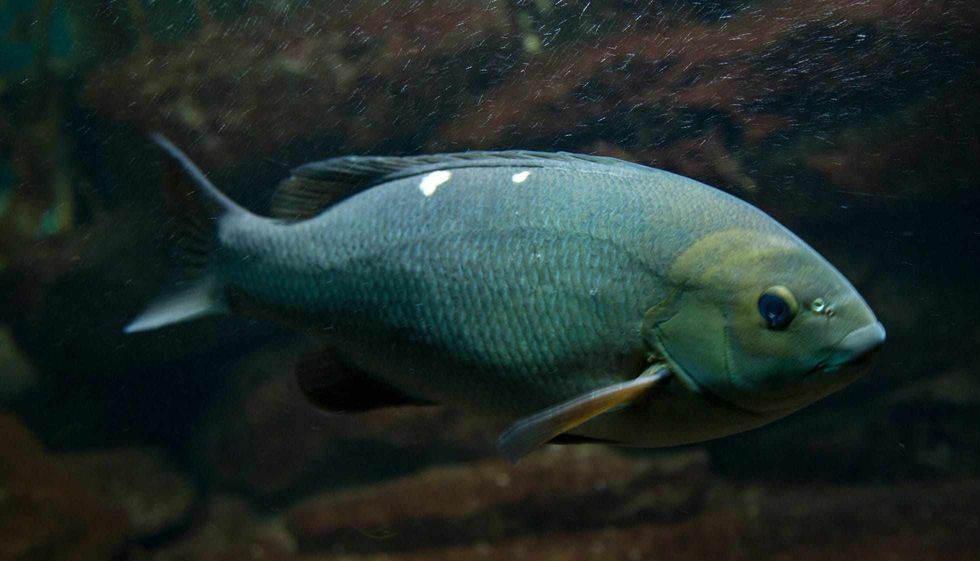The opaleye fish (Girella nigricans) species is a member of the Kyphosidae family. They are also known as 'rudderfish', 'California opaleye', and 'chopa verde' fish in Mexico. There are 18 species in the genus Girella across the world.
Adults have a gray-green to olive-green body color. They are usually found in large schools in the ocean, in rocky areas with lots of algae at depths up to 105 ft (32 m), and occasionally they will enter estuaries too.
Young fish are known as juveniles. They are pelagic and are most often found among floating debris at the water's surface. Their bright blue eyes make them unique to other marine species.
Opaleye (Girella nigricans) fish are found in Mexican waters, but they also have a limited range in other areas, including in the Sea of Cortez and along the west coast of Baja, as well as in many other regions of the Pacific Ocean.
They are often confused with the Gulf opaleye (Girella simplicidens), the half-moon (Medialuna californiensis), and the zebra perch (Hermosilla azurea). Commercial fishing of the opaleye is common since it is a delicacy that is served in several parts of the world.
They are also regarded as a difficult aquatic species to catch but are still a favorite angler's gamefish.
Aquatic animals can be quite amusing and interesting, so if you'd like to know more about them, keep reading, and also check out our piranha and yellowfin tuna facts for more.
Opal Eye Fish Interesting Facts
What type of animal is an opal-eye fish?
Opaleye fish is a ray-finned fish species.
What class of animal does an opal-eye fish belong to?
Opaleye (Girella nigricans), or rudderfish, belong to the Actinopterygii class.
How many opal-eye fish are there in the world?
The total population of Girella nigricans is unknown, but their population is stable and does not require extensive conservation efforts as of now.
Where does an opal-eye fish live?
Opaleye (Girella nigricans) fish live in the ocean at great depths, particularly in the Pacific Ocean, from California to Mexico, and around the Pacific Islands. They prefer temperate ocean waters and tropical waters, and they live between water beds.
What is an opal-eye fish's habitat?
Opaleyes dwell in shallow reefs with kelp beds and among rocky areas, and juveniles may be found in tide pools.
Adult opaleyes favor rocky areas with algae, while juveniles stay close to the sea surface, and move deeper as they mature. They can survive in temperatures as low as 46 F (7.78 C), but they find a warmer 95 F (35 C) much more tolerable and comfortable in their habitat.
They are found in Mexican waters, all the way up to southern California, and they have a small population in the Sea of Cortez.
Who do opal-eye fishes live with?
Opaleye (Girella nigricans) are known to live and travel in groups of at least four other fish of the same species in the sea.
How long does an opal-eye fish live?
This opal-eye California fish is known to live for 10 years.
How do they reproduce?
Spawning takes place from April to June, and females lay eggs in the water column since juveniles cannot stay in deep waters. However, after maturation, adult fish stay at great depths.
What is their conservation status?
The opal eye fish family has a Least Concern conservation status. This means that their population is stable, but despite this, some human activities like polluting the sea, overfishing, and climate change have contributed to a decline in their population in some regions.
Opal Eye Fish Fun Facts
What do opal-eye fish look like?
Opaleye fish is ovally perch-shaped. Juveniles have bright green coloring along their bellies and sides, while adults have an olive green or gray-green body color, along with bright blue to opalescent blue-green eyes. They have a continuous dorsal fin and their tail fin has a straight margin.
Opaleye perch usually also have two white spots on their upper back. Their dorsal fin has 12 to 13 spines and their anal fin has three spines with 10 to 13 rays.
As adults, they can grow to a maximum length of 25 in (63 cm). They also have a striking pattern of dots under their dorsal fin. Juveniles have a silvery ventral surface, along with a bluish dorsal surface.
How cute are they?
This fish species is cute to watch with its blue eye, perch green color, and olive-to-green color combination which can be observed in an aquarium under lights.
How do they communicate?
Very little is known about the means of communication among this fish species. It is difficult to study if they communicate underwater and whether they make sounds.
How big is an opal-eye fish?
The opaleye species is usually a medium size fish. At 25 in (63 cm), they are approximately five times bigger than an Atlantic mackerel.
How fast can an opal-eye fish swim?
The swimming speed of the opaleye species is not known exactly, but they may be able to swim at a similar speed range to mackerels. As a non-migratory species, they may not be as fast as other migratory fishes.
How much does an opal-eye fish weigh?
The opaleye can weigh up to 208 oz (5.8 kg). This makes them an attractive and challenging catch for anglers.
What are the male and female names of the species?
Male and female opaleyes do not have separate names. They are all simply generally known as opaleye fish.
What would you call a baby opal-eye fish?
Opaleye babies are simply known as juvenile fish or larvae.
What do they eat?
Opaleye fish are primarily herbivores and they feed largely on algae, seaweed, and kelp. However, they also commonly consume crustaceans or even worms that are attached to marine plants.
Are they poisonous?
This blue-eyed, perch-like green opaleye is not considered to be poisonous. They are served as a delicacy across the world. Many people carry out commercial fishing of the opaleye for their meat and as bait.
Would they make a good pet?
They are rarely kept as a pet but they can be found in big aquarium displays. Opaleye fish are usually calm and feed primarily on greens which can be quite easy to source.
However, as they grow to adulthood, they may require bigger and bigger tanks. Therefore, they make good large tank pets, but most people raise them commercially for their meat or as bait, rather than as a pet.
Did you know...
Opaleye fish can turn into a monotonous dark brown color when they die.
As long as an opaleye fish remains wet, it can breathe and survive even outside of a body of water for hours.
Some anglers specialize in opaleye fishing, and many of them believe that frozen peas or moss are the best bait to use when fishing for opal-eye fish.
Do they bite?
No, the green perch-like opaleye fish are rarely known to bite people, since they are primarily herbivores and are non-violent. However, their flapping fins may be sharp and could injure someone. Therefore, it is important to be careful when fishing for opaleye.
Can you eat opaleye fish?
Lots of fishermen consider the opaleye as baitfish, however, many people do eat opal eye. It can be eaten smoked, raw, and even fried.
They are served in different restaurants in various recipes, such as fried or in curries and many people think that it is a delicious fish! However, it is not among the most popular seafood cuisines in the world, like mackerel, tuna, or salmon.
Here at Kidadl, we have carefully created lots of interesting family-friendly animal facts for everyone to discover! Learn more about some other fish from our sockeye salmon facts and catfish facts pages.
You can even occupy yourself at home by coloring in one of our free printable angler fish coloring pages.










